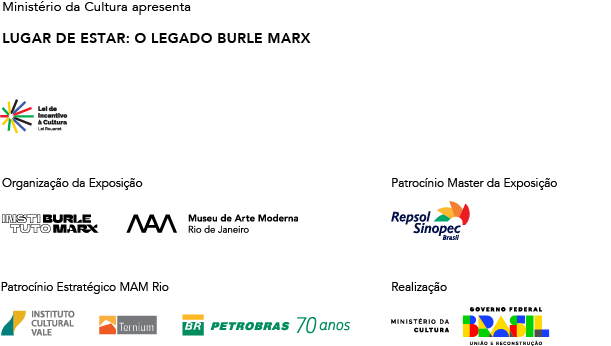Aterro do Flamengo
Rio de Janeiro (RJ), 1960 – 1963
General Coordinator: Maria Carlota Costallat de Macedo Soares
Burle Marx office
Landscape architect: Roberto Burle Marx
Associated architects: Maurício César Monte, Júlio César Pessolani Zavala, Fernando Táboa Pena and John Godfrey Stoddart
Morro da Viúva Restaurant and Aquarius Adequation | 1967 – 1970
Burle Marx office
Landscape architect: Roberto Burle Marx
Collaborating architects: Haruyoshi Ono, José Waldemar Tabacow
Adequation Marina da Glória | 1976 – 1978
Burle Marx office
Landscape architect: Roberto Burle Marx
Associated architects: Haruyoshi Ono, José Waldemar Tabacow
Reform [Glória neighbourhood] | 1987
Burle Marx office
Landscape architect: Roberto Burle Marx
Associated architect: Haruyoshi Ono
Collaborating architect: Roberto Garcia Roza
Collaborator landscape architect: Hugo Biagi Filho
Floristic Inventory | 1991 – 1992
Burle Marx office
Landscape architect: Roberto Burle Marx
Associated architect: Haruyoshi Ono
General Revitalisation RioMar Project | 1997 – 2000
Burle Marx office
Landscape architect: Haruyoshi Ono
Collaborator landscape architect: Vera Gavinho
Coordination: Denise Pinheiro
Collaborating Architect: Sonia Braga, Vera Assunção
Flamengo Park was part of the urban development project of Rio de Janeiro, constructed during Carlos Lacerda’s time as governor (1960-1965), during the commemoration of the city’s fourth Centenary. With 120 hectares, it is the result of a land fill of part of the waterfront that connects the central and the south zones of the city. Considered one of the most emblematic landscaping projects of the 20th century, the Aterro do Flamengo, as it’s also known, is one of the first parks designed according to modern concepts in Brazil. Responsible for the development and execution of the park project, a multidisciplinary working group led by Carlota Macedo Soares, also known as Lota, included architects, urbanists, educators, sports and lighting specialists, among others. Conceived as an urban garden that would offer a transition between the sea, the city and the mountains, and serve as a leisure and entertainment area, the Flamengo Park is today intensely frequented for recreational and sports activities, and for contemplation by several social strata of the city’s population, in addition to receiving tourists and events of all sizes.
The landscaping project by Burle Marx and its collaborators was divided into eleven sectors, with about 17 thousand trees planted and more than 240 species of Brazilian and other tropical plants, which bloom at different times of the year. Composed of winding paths, the topography offers the pedestrians broad and surprising perspectives over the walk, and the expressways follow in harmony with the accidents of the terrain. The composition of flowerbeds with vegetation is more detailed in the areas near the Museum of Modern Art, the Monument to the Dead of World War II, Marina da Glória and the former Morro da Viúva restaurant. In 2012, the city of Rio de Janeiro became the first in the world to receive the UNESCO World Heritage title of Urban Cultural Landscape, due to the relevance of public spaces such as the Parque do Flamengo and the Avenida Atlântica, both designed by Burle Marx and his collaborators.
